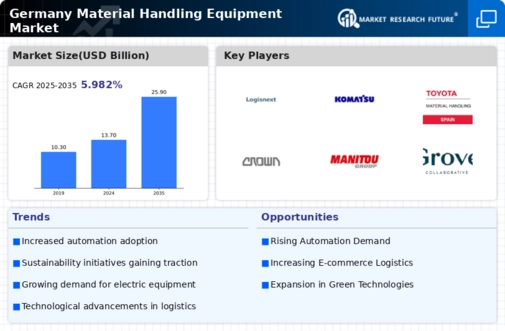Technological Advancements in Equipment
The material handling equipment market in Germany is experiencing a notable shift due to rapid technological advancements. Innovations such as IoT integration and AI-driven systems are enhancing operational efficiency and safety. For instance, automated guided vehicles (AGVs) are becoming increasingly prevalent, with a projected growth rate of 15% annually. This trend indicates a strong demand for advanced material handling solutions that can streamline processes and reduce labor costs. Furthermore, the integration of real-time data analytics allows companies to optimize inventory management and reduce waste, thereby improving overall productivity. As these technologies continue to evolve, they are likely to reshape the landscape of the material handling-equipment market, driving investments and fostering competitive advantages for early adopters.
Labor Shortages and Workforce Challenges
The material handling-equipment market in Germany is currently facing challenges related to labor shortages. With an aging workforce and a decline in skilled labor, companies are compelled to seek solutions that mitigate these issues. Automation and mechanization are emerging as viable strategies to address workforce challenges, leading to increased demand for advanced material handling equipment. The market is witnessing a shift towards automated systems that can operate with minimal human intervention, thereby ensuring continuity in operations. This trend suggests that businesses are likely to invest more in technology-driven solutions to compensate for labor shortages, thereby reshaping the material handling landscape.
Regulatory Compliance and Safety Standards
In Germany, stringent regulatory compliance and safety standards are driving changes in the material handling-equipment market. The implementation of regulations such as the Machinery Directive and the Occupational Safety and Health Act necessitates that companies invest in equipment that meets these requirements. This focus on safety not only protects workers but also enhances operational efficiency. As a result, manufacturers are increasingly developing equipment that incorporates safety features, such as automatic shut-off systems and ergonomic designs. The emphasis on compliance is likely to lead to a rise in demand for advanced material handling solutions that align with these regulations, thereby shaping the market dynamics.
E-commerce Growth and Demand for Efficiency
The surge in e-commerce activities in Germany is significantly impacting the material handling-equipment market. With online retail sales projected to reach €100 billion by 2025, companies are increasingly investing in efficient material handling solutions to meet consumer demands. This growth necessitates the adoption of advanced equipment that can handle high volumes of goods swiftly and accurately. Automated sorting systems and high-speed conveyors are becoming essential in warehouses to facilitate rapid order fulfillment. Consequently, businesses are likely to prioritize investments in material handling technologies that enhance efficiency and reduce lead times, thereby positioning themselves competitively in the evolving market landscape.
Sustainability Initiatives and Green Technologies
Sustainability initiatives are becoming a pivotal driver in the material handling equipment market in Germany. Companies are increasingly adopting green technologies to reduce their carbon footprint and comply with environmental regulations. The demand for energy-efficient equipment, such as electric forklifts and solar-powered conveyors, is on the rise. This shift is reflected in the market, where the share of sustainable equipment is expected to grow by 20% over the next five years. As businesses strive to enhance their sustainability profiles, investments in eco-friendly material handling solutions are likely to increase, influencing purchasing decisions and market trends.





















Leave a Comment